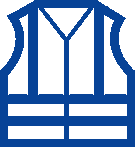
ISO 20471 standard
ENSURING HIGH VISIBILITY FOR THE WEARER, DAY AND NIGHT.
The ISO 20471 standard specifies requirements for high visibility clothing which is capable of visually signalling the user's presence for professional use. Category 2 PPE aims to make the user's presence visually obvious, so that he is more perceptible in hazardous situations, both day and night.
The ISO 20471 standard informs the wearer about the visibility provided by the clothing through 3 classes:



Minimum fluorescent* surface area
Minimum retroreflective* surface area
Class 1
Class 2
Class 3
0,14 m2
0,50 m2
0,80 m2
0,10 m2
0,13 m2
0,20 m2
The surface areas of fluorescent fabric and retroreflective materials are taken into account to define the 3 classes.
The fluorescent fabric ensures daytime visibility. It transforms part of the non-visible light (UV) into visible light. Yellow, orange and red create a contrast with the natural environment. The retroreflective material ensures night-time visibility. It reflects a maximum amount of light back towards its source (such as vehicle headlights for instance). Depending on the situation, certain types of tape are preferable.
Two retroreflective technologies:
MICROPRISMS :
-
Visibility in the rain
-
Poder retrorreflectante
-
Retroreflective power
-
Abrasion resistance
-
Sensitive to orientation
-
Low resistance to bending
-
Sensitive to temperature variations
MICROBEADS :
-
Insensitive to orientation
-
Resistant to bending
-
Flexible
-
Little customisation
-
Only available in one colour
-
Visibility in the rain
-
Low abrasion resistance
Which class should you choose for your PPE?
In vehicle traffic, high visibility clothing makes the wearer more visible to drivers. The standard defines which class is the most suitable according to the speed encountered :
Risk factors:
Class 1
Class 2
Class 3
Vehicle speed
Type of road
<= 30 Km/h
<= 60 Km/h
Passive
> 60 Km/h
